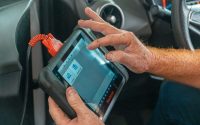Car Map Sensor: Ensuring Your Car Engine Works Ideally
Modern cars are equipped with many different sensors, one of which is the car MAP sensor. The MAP sensor plays a crucial role in the management of your car’s engine temperature. But what exactly does it do?
In this post, I will discuss what a MAP sensor is, how it works and why you should replace yours if there is any suspicion of failure. We will also look at some common problems people experience with their MAP sensor, as well as what symptoms could indicate a serious issue that requires professional assistance.
What is a MAP Sensor?
The term MAP stands for manifold absolute pressure. This sensor measures the amount of pressure in the engine’s intake manifold and sends its readings to the car’s computer. The computer then compares these readings with others from other sensors, such as the coolant temperature sensor and throttle position sensor. The car MAP sensor can also be referred to as a “TPS” which stands for “Throttle Position Sensor”. How Does It Work?
There are two different types of MAP sensors: static and dynamic. This refers to how they are mounted onto the engine. A static MAP sensor is mounted onto the engine block while a dynamic MAP sensor is attached to a moving component inside the intake manifold. The difference between these two sensors is that a dynamic one will be able to sense changes in pressure more quickly than a static one. This is because it is closer to the source of air entering the engine and therefore will provide more accurate readings.

A MAP sensor measures pressure by using a metal diaphragm that is connected to a potentiometer or variable resistor. When the engine’s throttle is closed, this causes an increase in vacuum which then pulls on the MAP sensor’s diaphragm and increases its resistance. When the throttle is opened, the manifold pressure increases which decreases the MAP sensor’s resistance. This information is sent to the car’s computer where it is processed and used to determine how much fuel should be delivered to the engine.
It is also important to note that a MAP sensor only measures one variable of many that are needed to calculate how much fuel should be delivered. Other variables include coolant temperature, air intake temperature and throttle position.
Why Should You Replace It?
There are many reasons why you should replace your MAP sensor if there is any suspicion of failure. First of all, a faulty MAP sensor can cause major damage to your engine. This is because it will not provide accurate readings which means that too much or too little fuel will be delivered to the engine. If too much fuel is delivered, then carbon deposits will haphazardly build up in your engine and cause excessive wear. If too little fuel is delivered, then the engine will not have enough power to run properly and again this can lead to excessive wear.
Replacing a faulty MAP sensor early on can save you from having to pay for expensive repairs down the road. Another reason why it’s important to replace your MAP sensor when there is any suspicion of failure is that if it fails completely, your car may stall while driving or even shut off completely. This poses a serious safety risk to you and your passengers as well as other motorists on the road.

What Symptoms Should You Look For?
There are many symptoms that can indicate a MAP sensor problem. The first symptom is an illuminated check engine light. If this happens, then it’s important to get your vehicle checked by a professional so they can diagnose why your check engine light came on. Another common symptom is rough idling or stalling when starting up or driving at higher speeds. You may also notice that your gas mileage decreases substantially.
Another symptom of a faulty MAP sensor is an engine that runs too hot or too cold. If the MAP sensor fails, then the computer will not be able to determine how much fuel should be delivered which means that it will run erratically and cause excessive heat or cold. The reason why this happens is that the computer believes there is either too much or too little fuel in the engine when there really isn’t.
Another common symptom of a MAP sensor problem is if your car starts to idle roughly after making a round trip or long drive. This can be due to the fact that when driving on the highway, there is less load on the engine which means that it will idle much slower. When you return home and turn off the car, then the computer will attempt to bring the RPMs back up but this may cause some stalling.
If you notice any of these symptoms, I would recommend having your vehicle checked out by a professional so they can diagnose why your check engine light came on and if there is any damage to the engine.



